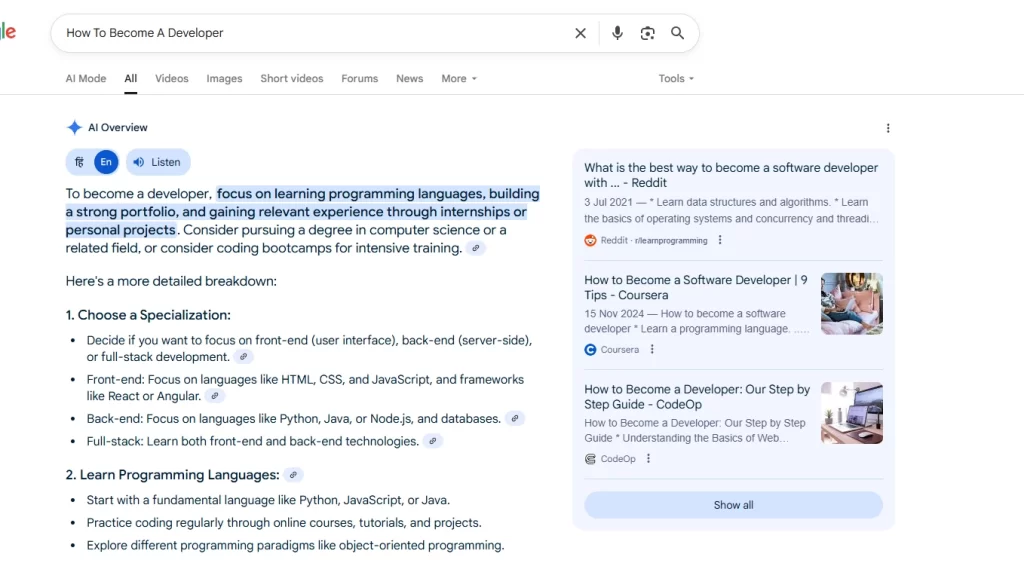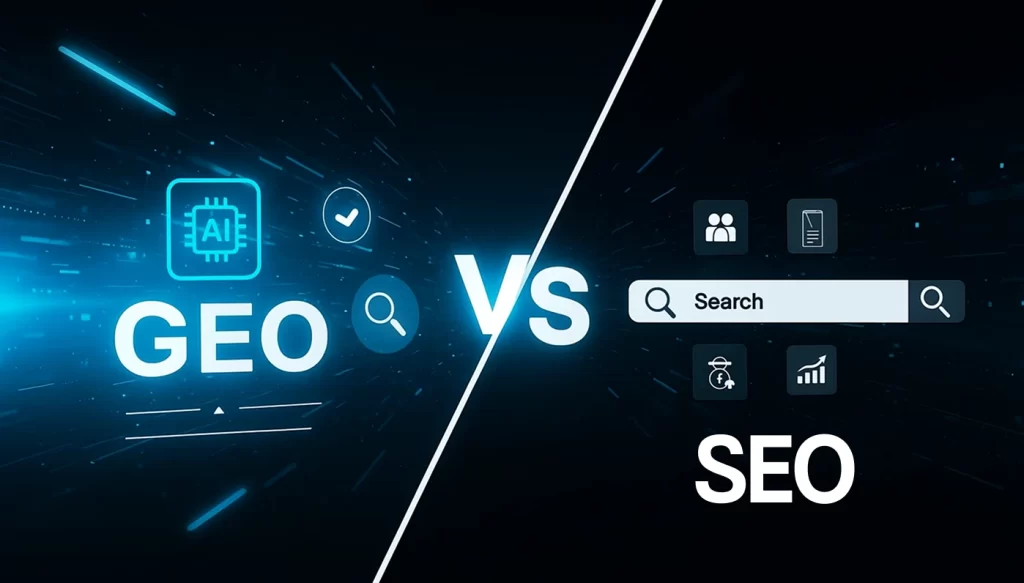How GEO Is Reshaping SEO and What You Should Do Now

Have you ever heard the term Generative Engine Optimization or GEO? If not, you might be thinking, is it just new marketing slang or something else? Is it just modern SEO or a step ahead?
But you might be surprised to know that this term has become one of the biggest marketing buzzwords. Infact, GEO is closely tied to the rise of AI SEO. No doubt, SEO has been the gold standard for businesses for years. We’ve all chased optimizing on-page, building quality backlinks, finding authoritative keywords, and giving a green flag to all the technical stuff to win the organic ranking battle.
GEO is now setting new standards while many are still stuck playing the old game. If you’re still putting all your energy into traditional link building, it’s time to rethink.
So let’s look at what it is and how your business can adapt to it.
GEO is the process of creating content in a way that aligns well with AI-powered search results. Just like traditional search engines, generative AI platforms like Gemini or ChatGPT crawl all the information available on the internet before presenting it to the end user.
AI-powered search isn’t just another Google update. It’s a complete reshaping of how information is collected, processed, and delivered. If you haven’t started implementing GEO, you might start noticing a slip in your organic traffic, even when you’re doing everything “right.” That’s because search engine behavior is evolving and no longer responds the way it used to.
| Did You Know? Google believes its AI Overviews will reach one billion users before the end of the year. |
Generative platforms like Google’s AI Overview, ChatGPT, Perplexity, and Gemini don’t just give you a list of links when you search. Instead, they fetch pieces of information from different sources and compile them into one clear, conversational answer.
To understand this better, take a simple example: “How to become a developer.”
Google now provides a direct answer on the left side, while the sources it pulled from appear on the right.

How Does GEO Work?
Generative Engine Optimization (GEO) blends AI-driven content generation with traditional SEO practices to enhance search rankings and user engagement. The process begins by leveraging AI tools (like GPT-4 or Google’s BERT) to analyze top-ranking content and identify patterns in keywords, structure, and user intent.
The AI then generates high-quality, contextually relevant content that aligns with these insights, optimizing for both search engines and user experience. After generating content, AI further enhances it by optimizing on-page SEO elements like meta descriptions, title tags, keywords, and internal links.
Results are typically generated in two ways:
Large Language Models (LLMs) are trained on vast and static datasets compiled from diverse sources like books, articles, and websites.
Retrieval Augmented Generation (RAG) models fetch real-time information from organic search results.
These two models directly influence GEO rankings. So, the content that ranks well on organic search is more likely to answer specific user queries. It appears more reliable and has a higher chance of being pulled into AI overview responses.

What’s The Difference Between GEO & SEO?
At their core, both GEO and SEO aim to increase the visibility of your content, but both of them operate in a fundamentally different way.
| Feature | SEO | GEO |
| Primary Goal | Ranks well in SERP results ( Search Engine Result Page) | Ranks well in AI-generated responses |
| Target | Traditional search algorithms such as Google, Bing. | Generative AI engine algorithms such as Chat GPT, Gemini, Perplexity etc |
| Output | High ranking in web pages. | Inclusion of citations or content snippets in AI-generated content. |
| Key Tactics | Keyword optimization, building backlinks, on-page and off-page optimization | AI-friendly content, structured data, and factual accuracy |
| Content Focus | Authority building for higher rankings | Clear context, clarity, and trustworthiness for AI understanding and synthesis |
| Measurement | SERP rankings, bounce rates, organic traffic. | Mention in AI-generated answers, referral traffic from AI platforms. |
Core Elements of a GEO-Optimized Strategy
Brands generally shape their GEO results through the following strategies:
1. Using Customer Insights To Create High-Quality Content
The data you collect should empower you to create high-quality content that meets the unique interests of your customers and earns their trust.
2. Building Your Assets
Brands that publish and maintain their digital assets are seen as reliable and authoritative. This builds credibility. So, if chatbots rely on your content to generate responses, it positions your brand as a trusted source.
3. Strategic Optimization Techniques
By optimizing content carefully, brands can increase their chances of being featured in generative AI responses.4. Publish “Top 10” or Comparison Content
Large language models, such as ChatGPT or Gemini, tend to prefer content that is structured, concise, and formatted in predictable ways, like listicles or side-by-side comparisons. This makes it easier for AI models to extract and present information.
For example: “What are the top 10 CRM tools?”
4. Publish “Top 10” or Comparison Content
Large language models, such as ChatGPT or Gemini, tend to prefer content that is structured, concise, and formatted in predictable ways, like listicles or side-by-side comparisons. This makes it easier for AI models to extract and present information.
For example: “What are the top 10 CRM tools?”
How To Integrate GEO With SEO
Now that we have learned the basics about GEO, let’s quickly dive into how to integrate it into your SEO strategy.
Step 1: Research AI queries and user intent
How can you think about combining SEO with GEO if you don’t know what your audience is looking for?
In SEO, you usually research the keywords people search on Google. In GEO, you go a step further, you research the kind of phrases and questions people ask during AI-driven searches and how AI interprets that context.
To start integrating GEO with SEO, focus on using long-tail, conversational phrases. AI SEO techniques can guide you in identifying the type of natural language queries users are asking.
One example could be: “How do I optimize my website to rank in AI?” or “What factors influence a website’s ranking in AI search?”
The next step is to perform an AI SERP analysis. For example, ask a question on ChatGPT, and when it provides an answer, analyze the sources it used, the tone and format it employed, and whether the keywords were used exactly or with slight variations.
In short, learn how people ask and how AI responds.
Step 2: Make Your Content AI Readable
Once you understand what people are searching for on AI platforms, the next step is to create content that’s easily digestible by both AI and humans. AI prioritizes content that is well-structured, clear, and concise.
Follow these practices to optimize your content:
- Use clear headings and subheadings that explicitly describe the section content. This helps AI easily identify and fetch relevant parts.
- Make your content conversational. Content filled with technical jargon or corporate speak may be ignored. Aim for a tone that’s simple, lucid, and engaging.
- Use bullet points or tables to separate and present information point by point. This structure is easier for AI to scan and interpret.
- Answer the core questions at the top, similar to how featured snippets work. If the AI needs a quick summary, it can fetch it from the top; if more detail is required, it can pull from the deeper sections.
Step 3: Follow the E-E-A-T Principle
No matter how good or factual your content is, if your site lacks authority in its niche, AI platforms are less likely to consider it. AI models are now well-trained to evaluate a website’s credibility before quoting or recommending its content to users.
Here’s how to apply the E-E-A-T principle in practical terms:
- Experience & Expertise – Your content should be written by someone with real knowledge of the subject. Always include the author’s name and bio to build credibility. This signals to both AI and users that the content isn’t created by a generic or unqualified source.
- Authoritativeness – Just like in traditional SEO, quality backlinks and credible references matter in GEO too. Establish authority by publishing original, well-researched content that others find valuable and trustworthy.
- Trustworthiness – Be transparent and ethical. If you use images or data from external sources, make sure to properly cite them and provide links. Also, ensure your content is professional, accurate, and grammatically correct. These factors strongly influence how AI ranks and values your content.
Step 4: Promote Content Across Multiple Platforms
Publishing and praying that it ranks well is not a smart marketing strategy. GEO does not rely on a single platform to generate answers. Instead, it pulls content from various platforms like social media, video transcripts, and Q&A forums.
This means your content should be visible beyond your website. Expanding your content distribution increases the chances of AI platforms discovering it easily.
Consider these tips:
- Display your content on multiple platforms
You don’t need to post the entire content, just highlight key points on platforms like Instagram, Facebook, Twitter, and LinkedIn. - Participate in relevant forums
Engage in niche-specific spaces such as Quora, Reddit, or Stack Exchange, where valuable conversations are happening. - Use multiple content formats
Avoid sticking to only one format. Use videos, infographics, carousels, or GIFs to present your message differently. - Encourage and engage in discussions
Create posts that invite interaction. When someone asks a question in comments or threads, your response can also serve as searchable and AI-discoverable content.
Step 5: Structured Data and Schema Markup Implementation
If you want your content to easily crawl on Google and make it easily digestible for AI models, the most powerful way to use it is by using structured data or schema markup.
Structured data is organized information formatted in a way that search engines can easily understand, often using standardized formats.
Schema markup is a type of structured data that uses a specific vocabulary (from Schema.org) to label and define content on web pages, helping search engines display rich results.
Here are some schema types for your reference
FAQ Schema
If your website includes a dedicated Q&A page or FAQs at the bottom of your content, marking it up with FAQ schema is highly beneficial. It helps search engines understand the format better and display it more clearly in results.
How-to Schema
Perfect for content that walks users through a step-by-step method, like guides or tutorials. This schema type gives users a more detailed view and enhances the chances of your content being featured in rich results.
Article or Blog Posting Schema
Use this to highlight essential details such as the author’s name, date of publication, and headline. It helps build trust and shows Google the relevance, freshness, and credibility of your content.
Organization Schema
Helps identify your business, providing details like logo, contact information, and social profiles, which adds legitimacy to your brand in search results.
Product Schema
If your website includes eCommerce or product-related pages, adding this schema can help AI and search engines understand what your product is about, making it easier to show up in relevant product recommendations.
Step 6: Optimize For Conversational Queries and Voice Searches
One of the biggest drivers behind GEO is the growing use of voice assistants and the shift toward more natural, conversational searches.
When someone talks to Siri, they usually ask, “Hey Siri, what’s the best product development company in Sydney for a small team?” rather than typing that out word by word.
To align your content with this shift:
- Use headings that sound like actual questions people would ask
- Write in a conversational tone using words like “you” and “your.” Read it out loud, and if it sounds robotic or flat, tweak it
- Make sure to answer the who, what, why, and when, since voice queries often begin with these questionnaire forms
- And don’t forget the basics, make sure your site’s technical performance supports fast and accurate responses.
Step 7: Performance Monitoring and Adapt Continuously
Both SEO and GEO are not set and forget strategies; they need regular check-ins and adjustments. Once you’ve implemented all the right steps, your job is far from over. You need to stay in the loop and adapt as search behavior evolves.
For traditional SEO, you track metrics like click-through rate, keyword rankings, and conversions. But when it comes to GEO, the feedback loop works differently.
Here’s how to approach it:
- Keep checking how your content performs across AI platforms like ChatGPT, Perplexity, and Google’s AI Overviews. Search key queries and see if your content is showing up. If not, then who is and why?
- With the rise of zero-click searches, start focusing more on impressions and content visibility rather than just clicks.
- Monitor how much time users are spending on your AI-optimized pages and keep an eye on bounce rates, which show if users are engaging with what they find.
- Use the GA4 (Google Analytics) engagement section to view average engagement time per page or heatmap tools to evaluate how engaging your AI-targeted content is.
Wrapping Up,
The world of AI and GEO may sound overwhelming initially. But remember one thing: the heart of SEO has not changed. SEO has always been about crafting genuine content that is helpful for the masses. And the same principle applies to GEO.
Sure, there are new ways to optimize it, but if you focus on delivering trustworthy and clear information that taps into the pain points and desires of your end user, you are already doing GEO in your way.
You simply need to embrace it now, blend it into your SEO strategy, and your website will not just rank, it will become the trusted answer everyone is searching for.And if you need a helping hand by your side, SEOBookLab is right here to roll up its sleeves and make your content AI-ready from the ground up.

